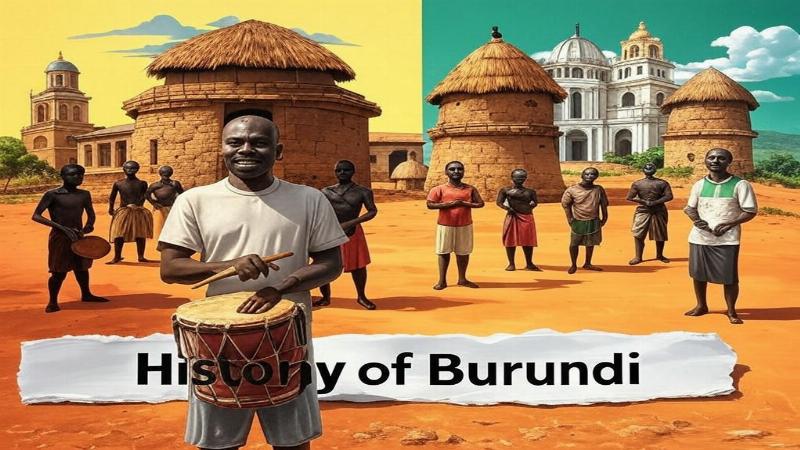Place for ads

Burundi, a small nation in East Africa’s Great Lakes region, is a land where rolling hills cradle a complex past. Covering 27,834 square kilometers, it sits between Rwanda, Tanzania, and the Democratic Republic of the Congo, its shores kissed by Lake Tanganyika. Known today for its coffee, resilience, and cultural depth, Burundi’s history weaves together ancient kingdoms, colonial upheavals, and modern struggles. In this article, we’ll journey through Burundi’s past, from its earliest days to its contemporary identity, uncovering the milestones that have shaped this enduring country.
Burundi’s human story begins around 100,000 BCE, with hunter-gatherers roaming its highlands. Archaeological finds—like stone tools near Muyinga—suggest these early peoples tracked game across the region’s fertile plains. By 3000 BCE, Neolithic farmers settled, leaving pottery at sites like Gitega, growing sorghum and raising goats.
The Iron Age (500 BCE) brought Bantu migrations from West Africa—iron smelting at Mirama hints at their skills. These newcomers blended with indigenous Twa (Pygmy) hunter-gatherers, forming the Hutu majority by 1000 CE. Later Tutsi pastoralists arrived, their cattle herding shaping Burundi’s social fabric.
By the 16th century, the Kingdom of Burundi emerged under Ntare I Rushatsi—legend says
Place for ads
The kingdom thrived on cattle and trade—beans and salt flowed to Rwanda and Tanzania. Unlike neighbors, Burundi resisted slave raids from the coast, its hills a natural shield. By the 19th century, under Mwami Ntare IV (1796–1850), it peaked—his reign saw stability, though Hutu-Tutsi tensions simmered beneath.
The late 19th century brought Europeans—German explorers arrived in the 1880s, claiming Burundi for German East Africa in 1890. Mwami Mwezi IV Gisabo resisted—battles near Kigwena in 1903 forced his submission. Germany ruled lightly from Tanzania, using Tutsi chiefs to collect taxes, deepening ethnic divides.
World War I shifted control—Belgian troops seized Burundi in 1916, ending German rule. The 1919 Treaty of Versailles handed it to Belgium under a League of Nations mandate, renaming it part of Ruanda-Urundi. Colonialism reshaped Burundi, planting seeds of future conflict.
Belgium tightened control—Gitega hosted administrators who favored Tutsi elites, codifying Hutu subordination. Cash crops like coffee drained fields, while forced labor built roads—resentment grew among Hutu farmers. Catholic missions spread, converting most by the 1940s, though royal traditions endured.
The 1959 Rwandan Revolution—where Hutu ousted Tutsi—rippled into Burundi, sparking unrest. Prince Louis Rwagasore, a nationalist, founded UPRONA, uniting Hutu and Tutsi for independence. His 1961 assassination—blamed on Belgian-backed rivals—stoked chaos, but his dream persisted.
On July 1, 1962, Burundi gained independence as a monarchy under Mwami Mwambutsa IV. Early years faltered—Hutu-Tutsi power struggles erupted, worsened by Rwanda’s violence. In 1965, Hutu rebels attacked— reprisals killed thousands, and Mwambutsa fled. His son, Ntare V, took the throne in 1966, only to be ousted by Capt. Michel Micombero’s coup.
Micombero’s 1966 republic ended the monarchy—Tutsi dominated, sparking the 1972 Hutu uprising. The army’s response—a genocide—killed 200,000 Hutu, displacing more. Ethnic scars deepened, setting a cycle of coups—Jean-Baptiste Bagaza (1976) and Pierre Buyoya (1987) ruled amid repression.
The 1993 election of Melchior Ndadaye—Burundi’s first Hutu president—offered hope, but Tutsi soldiers assassinated him in weeks, igniting civil war. From 1993 to 2005, Hutu rebels (CNDD-FDD) fought Tutsi forces—300,000 died, cities like Bujumbura bled. The 1996 coup reinstated Buyoya, but peace eluded.
The 2000 Arusha Accords, brokered by Nelson Mandela, set power-sharing—Pierre Nkurunziza’s 2005 election as Hutu president ended major fighting. Rebel holdouts lingered, but Burundi exhaled—refugees returned, though trauma and poverty lingered.
Today, Burundi’s 12 million people navigate recovery—Nkurunziza’s 2015 third term defied limits, sparking protests and a failed coup. Violence killed 1,200— he died in 2020, succeeded by Évariste Ndayishimiye, promising reform. Gitega replaced Bujumbura as capital in 2019, a symbolic shift.
Coffee and tea exports struggle—90% farm, but poverty grips 65%. Lake Tanganyika’s fish and Kirundo’s birds draw tourists, while Ingoma drums and basketry shine. Ethnic tensions ease, but authoritarianism and refugees—400,000 fled since 2015—test progress.
Burundi’s history is an East African saga—from royal drums to colonial chains, war’s ashes to fragile peace. Its hills echo with ancient unity, its people pulse with hope. As Burundi strides forward, its past fuels a legacy of endurance and rebirth.
Place for ads